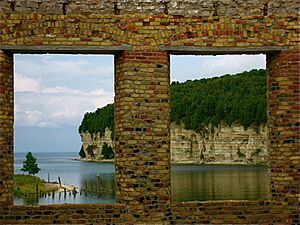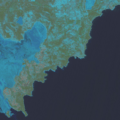Garden Peninsula facts for kids
The Garden Peninsula is a long piece of land, about 22 miles (35 km) long, that sticks out into Lake Michigan. It's located in the Upper Peninsula of Michigan. Lake Michigan is on its east side, and a large bay called Big Bay de Noc is on its west side.
You can reach the bottom of the peninsula using U.S. Highway 2. The west side of the peninsula is also accessible by M-183. The biggest town on the peninsula is Garden, Michigan.
Long ago, many of the peninsula's hardwood trees were cut down. These trees were used to make charcoal. This charcoal then fueled big furnaces that made iron. The Jackson Iron Company ran these furnaces from 1867 to 1891. You can still see where this happened at Fayette Historic State Park, which is on the peninsula's western shore. By the 1890s, most of the valuable timber on the Garden Peninsula had been logged. This was because it was easy to ship the wood across the Great Lakes.
Even after most of the old, big trees were gone, the area still has special plants. Some plants are endemic, meaning they only grow there. Others are disjunct, meaning they are found far away from their main growing areas.
After the logging stopped, people tried to farm the cleared land. They hoped to grow crops and build an economy. However, most of these farming efforts didn't work out well in the 20th century. One big success was growing fruit, especially strawberries. Much of the land that was cleared for farming has now grown back into new forests. These forests are part of the Lake Superior State Forest.
How the Garden Peninsula Was Formed
The Garden Peninsula is made of a type of rock called limestone. It's part of a long ridge of limestone called the Niagara Escarpment. Another part of this same rock ridge is the Door Peninsula in Wisconsin.
Over many years, huge sheets of ice called glaciers moved across the land. These glaciers wore away parts of the limestone ridge between the Door and Garden peninsulas. Today, a group of islands stretches across this gap. These islands help to enclose Green Bay, which is the largest bay in Lake Michigan.
The limestone hills on the Garden Peninsula can reach as high as 165 feet (56 meters) above the water. You can see these tall cliffs at places like Burnt Bluff, south of Fayette.
The waters around the Garden Peninsula are full of islands and are still a good place to catch freshwater fish. One of the peninsula's largest bays is called Gillnet Haven Bay. It's located southeast of Fayette. This bay got its name from the gill nets that Native American fishermen used to catch fish in Lake Michigan.
Images for kids



